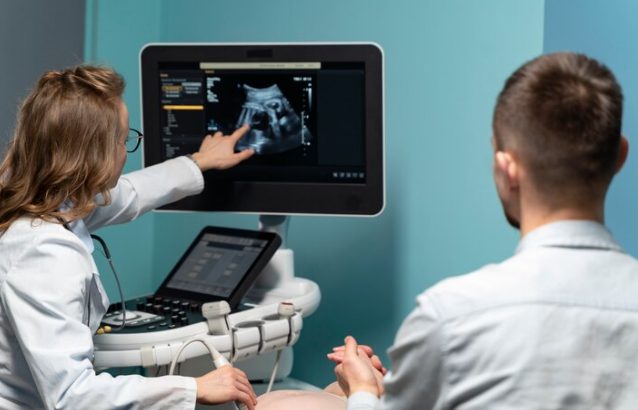
@ShahidNShah


Pregnancy is a journey filled with joy, anticipation, and tremendous responsibility. It is also the time when healthcare comes to the fore and addresses the mother’s needs and the needs of the baby she carries. With new technological innovations, wearable devices have taken the stage in helping pregnant women with maternal health. These include monitoring the baby’s heartbeat, keeping tabs on the mother’s vitals, and so much more, giving a pregnancy a more manageable state.
Here, we discuss how wearable devices like fetal heartbeat monitoring devices, Doppler fetal monitors, and other forms of technology change health care for pregnant women to have a safer, healthier pregnancy.
Pregnancy is a precious and delicate time where both maternal and fetal health need constant care and attention. Regular monitoring plays a crucial role in identifying potential complications like high blood pressure, gestational diabetes, or fetal distress early on, giving mothers peace of mind and ensuring their baby’s well-being. Thanks to wearable devices, expectant mothers can now track important health metrics in real time, thus cutting unnecessary hospital visits.
While traditional methods of fetal monitoring have been effective, they often do not reach the desired goals, such as accessing healthcare facilities or the inconvenience of checkups. This is where wearable technologies fit in. Advanced fetal heartbeat monitors and Doppler fetal monitors make monitoring the baby’s health during pregnancy even easier, more accessible, and highly intuitive. More information and tools for supporting your pregnancy journey can be sourced from other reliable sources, like the best pregnancy website, which guides you on how to take care of yourself and live healthily during this key period.
Fetal heartbeat monitors are wearable devices designed to show the heartbeat of a fetus in real time. Their noninvasive methods will allow women to have proper information related to their baby’s overall health. It comes in smartphones with applications through which any woman can listen to and also track her baby’s heartbeats right from their home.
These gadgets give confidence and can serve as an early warning system in case of any abnormalities. More advanced models include comprehensive analytics that offer a more detailed view of pregnancy to help healthcare providers make timely and informed decisions regarding pregnancy.
How They Work:
Fetal heart monitors utilize ultrasound technology in detecting and amplifying the fetal heartbeat, thus making it audible. This is particularly helpful in the later stages of pregnancy when close monitoring of fetal activity is essential.
Doppler fetal monitors use Doppler ultrasound technology to detect the baby’s heartbeat, offering real-time insights into the fetal heart rate and movement. These devices are widely used in monitoring pregnancies for possible risks, such as irregular heart rhythms or abnormal fetal development.
Advantages of Doppler Fetal Monitors:
Doppler fetal monitors are recommended to expectant mothers who wish to monitor their baby’s development to catch any irregularities early enough for timely medical intervention.
Apart from fetal monitoring, most wearable devices are designed for tracking maternal health. Examples include blood pressure, oxygen levels, and sleep patterns, among others, which are needed to identify complications such as preeclampsia or gestational hypertension. Some examples include smart maternity bands; these are becoming popular by providing real-time data on the health of the mother while integrated with apps to offer holistic pregnancy management.
Features of Smart Bands:
By providing a holistic view of the mother’s well-being, these devices ensure proactive health management, thereby preventing complications before they get worse.
Wearable contraction monitors track contractions throughout pregnancy, helping pregnant women identify preterm labour signs earlier. The device provides constant monitoring, giving the user a signal if irregular contractions or signs of preterm labour occur.
Benefits of Wearable Contraction Monitors:
Wearable contraction monitors give peace of mind: They can detect irregular contractions and, hence, prevent preterm birth and allow early intervention if required.
Maternity belts support the expanding stomach, take strain off of the back, and are really comfortable. Modern intelligent maternity belts help beyond the mechanical functions. For example, some use sensors for monitoring parameters, such as maternal heart rate, contraction pattern, and movement of the fetus.
Advantages of Smart Maternity Belts:
Smart maternity belts combine physical comfort with health monitoring, making them an ideal choice for mothers looking to manage their health and the baby’s well-being during pregnancy.
Wearable devices are not only monitoring but also enhancing maternal health by providing proactive care solutions. Here’s how:
Wearable devices provide continuous data to help in the early detection of problems such as fetal distress or abnormal maternal vitals, allowing for timely intervention before the situation becomes severe.
Wearable devices use AI and machine learning to analyze the collected data to provide insights. For example, a Doppler fetal monitor can flag any deviation in fetal heart rate trends, thereby requiring further medical evaluation.
Monitoring the health of the fetus and mother from home reduces stress and the need for frequent visits to the hospital. This also gives mothers more control over their health, which will increase their bonding with their babies.
Wearable devices have storage capabilities and can share information with healthcare providers, providing a holistic approach to pregnancy care. Continuous streams of data enhance decision-making and outcomes for mother and baby.
Promote Bonding:
Hearing your baby’s heartbeat through a fetal heartbeat monitor can be a deeply emotional experience. It creates a special connection, offering reassurance and comfort as you feel your little one’s presence even before birth.
Enable Mobility:
Wearable devices allow you to stay connected to your baby’s health while still enjoying the freedom to go about your daily life. You don’t have to sacrifice mobility or peace of mind—these devices let you monitor both maternal and fetal health without interruptions.
Support High-Risk Pregnancies:
For women with high-risk pregnancies, wearable devices provide a sense of security by constantly tracking both the baby’s heartbeat and the mother’s health. If any complications arise, healthcare providers can respond quickly, offering the best care possible for both mother and child.
While wearable devices are changing maternal health, they have their drawbacks. Misinterpretation of data, over-reliance on devices, and the possibility of inaccuracies are some of the drawbacks.
To mitigate these, expectant mothers should:
In addition, following local healthcare regulations is crucial to ensure that these devices are safe and effective.
Wearable devices such as fetal heartbeat monitors, Doppler fetal monitors, and maternal health trackers are changing the face of pregnancy. Combining technology with healthcare, they offer unmatched support in monitoring and enhancing maternal health during pregnancy.
These devices bring more to expectant mothers than just the data: peace of mind, convenience, and a more profound connection to their journey. With technological advancement, these wearable devices are sure to play even more significant roles in ensuring safe and healthy pregnancies worldwide.
Whether it is tracking fetal health or managing one’s own vitals, these innovations bring the power of modern healthcare into the hands of mothers, making every step of the pregnancy journey safer and more informed.
Wearables for maternal care are devices designed to monitor both the mother’s and the fetus’s health, including fetal heart rate, movements, and maternal activity. These devices help reduce pregnancy-related risks by providing continuous health data.
Technology improves pregnancy and birth outcomes by monitoring vital signs, physical activity, and labouring positions. Wearable sensors offer more precise and accurate data compared to traditional methods, enhancing prenatal care and ensuring timely interventions.
A maternal-fetal monitor is used to track the baby’s heart rate, both during prenatal visits and labor. It helps healthcare providers monitor fetal well-being, using an ultrasound probe to detect the baby’s heart rate and identify any issues early.
Fetal monitoring helps track the baby’s heart rate and oxygen levels during labour. If oxygen levels drop, the heart rate may change, alerting healthcare providers to take action to protect the baby and avoid complications such as fetal distress.

Google announced a new suite of tools called Health AI Developer Foundations (HAI-DEF) that will help enable developers to more efficiently. What You Should Know: – Google has introduced Health …
Posted Nov 26, 2024 Software Developers IT
Connecting innovation decision makers to authoritative information, institutions, people and insights.
Medigy accurately delivers healthcare and technology information, news and insight from around the world.
Medigy surfaces the world's best crowdsourced health tech offerings with social interactions and peer reviews.
© 2025 Netspective Foundation, Inc. All Rights Reserved.
Built on Dec 19, 2025 at 2:02pm